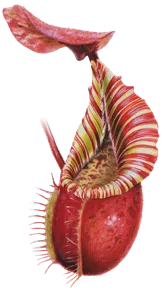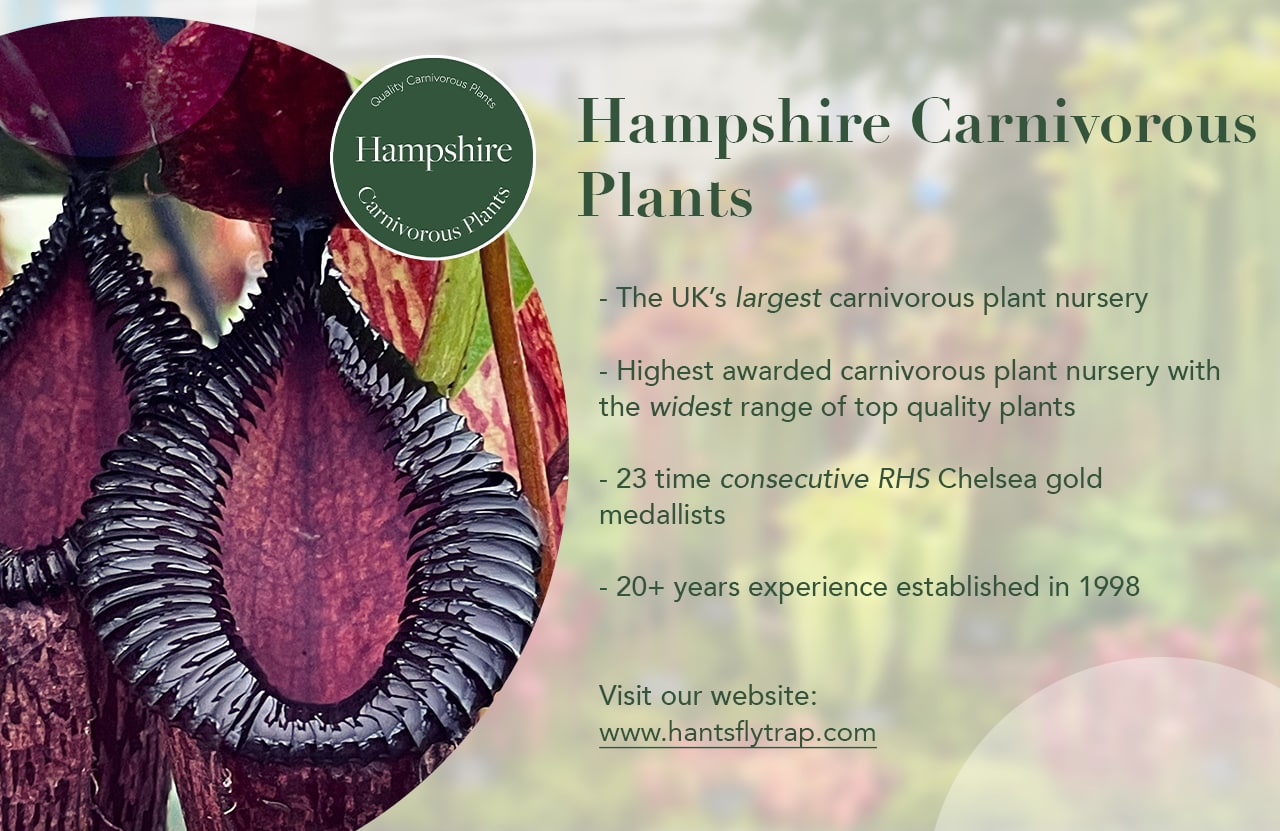Nepenthes nebularum
 A fully aged pitcher, the peristome darkened to a deep rusty red and the body to brown
A fully aged pitcher, the peristome darkened to a deep rusty red and the body to brown  Fresh pitcher, back when the plant was smaller
Fresh pitcher, back when the plant was smaller 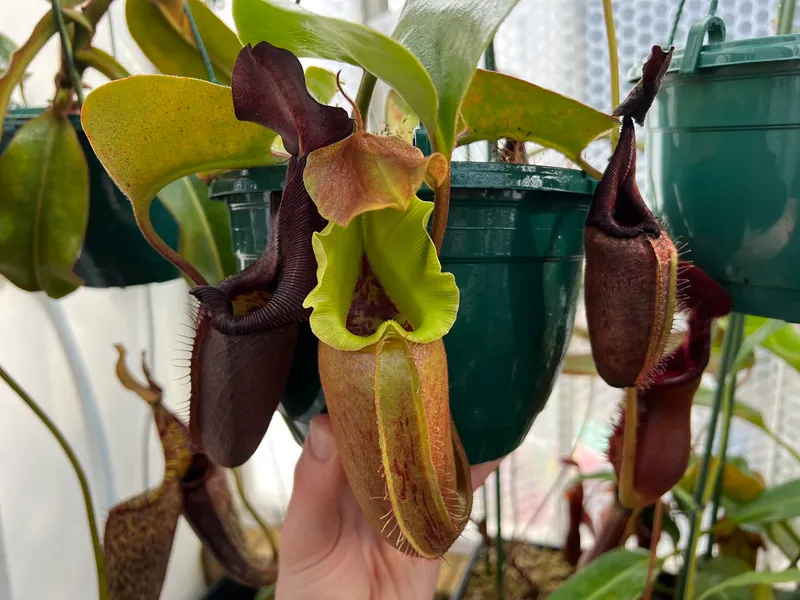 Freshly opened pitcher - note the solitary stripe on the yellow peristome
Freshly opened pitcher - note the solitary stripe on the yellow peristome 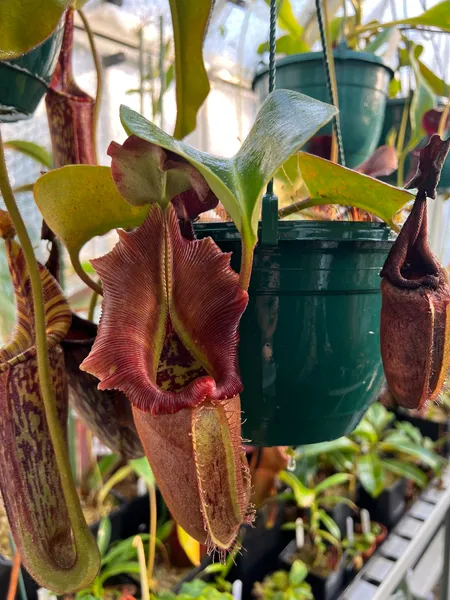 I love the flared peristome on this species. This is clone 5 from Wistuba
I love the flared peristome on this species. This is clone 5 from Wistuba  Like N. robcantleyi and N. truncata, this species has huge, glossy, heart-shaped leaves
Like N. robcantleyi and N. truncata, this species has huge, glossy, heart-shaped leaves 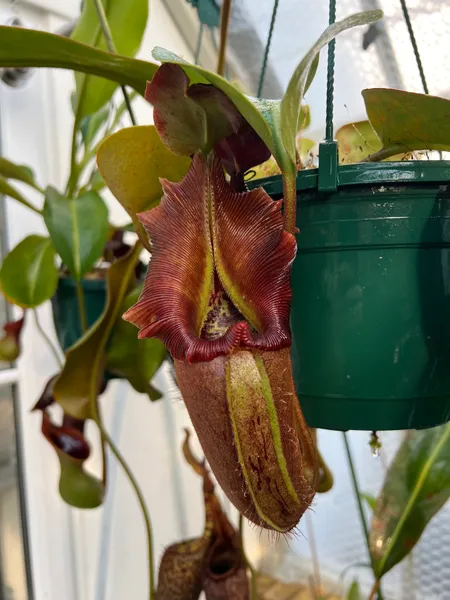 The mid-point in the pitcher's lifecycle - a striking red peristome
The mid-point in the pitcher's lifecycle - a striking red peristome Description & Care
Nepenthes nebularum is - like its close relative N. robcantleyi - a species steeped in controversy! Should it be regarded as a subspecies of N. robcantleyi? Is N. robcantleyi itself a natural hybrid between N. nebularum and N. truncata? I’m not going to focus on these debates today. If you feel particularly strongly one way or the other, I suggest you head on over to my page on Nepenthes robcantleyi. Here, I’ll instead focus on my experiences growing N. nebularum.
This species is a native of Mindanao in the Philippines, where it grows in the trees as an epiphyte. Like N. truncata, it has large, glossy, heart-shaped leaves and can produce enormous pitchers when mature. The pitchers on most cultivated plants (including mine) are orange when freshly-opened, but darken to a coppery brown as they age. Soft, fuzzy hair covers the pitcher body - not long or as coarse as the prickly indumentum on N. veitchii, but striking nonetheless. The peristome is bright yellow on fresh pitchers, darkening first to red and finally to a magnificent shade of purple or black. The whole pitcher is much darker than most cultivated N. robcantleyi.
Two characteristics separate it from its close relatives. First is its small flowers. While I’m yet to flower this species myself, I know that my female N. robcantleyi produces an enormous inflorescence over a metre in height that holds dozens of flowers. Photos of N. nebularum flower spikes and seed heads show them to be comparatively small.
Second, you’ll notice in my photos above that the tendrils tend to curve inwards back towards the centre of the plant. I keep my N. nebularum in a hanging basket, and the tendrils tend to clamp onto the outside of the basket before hardening as the pitcher inflates, anchoring the plant firmly in place. I suppose this reflects its strong preference in the wild for an epiphytic growth habit.
All in all, it’s a lovely species to grow. My plant (which is designated Clone 5 ‘Mt Mayo’ from Wistuba) seems very happy in typical highland conditions - 12°C (54°F) minimum year-round and at least 60-70% humidity, although it prefers the warmer time of year. By contrast N. truncata has never grown particularly well for me, aside from the famous ‘reddish leaves’ highland clone from Wistuba.
How I Grow It
| Media | Long fibre sphagnum moss, perlite, and - optionally - orchid bark (2:1:1). |
| Water | Damp but not wet. |
| Light | Many report the leaves spot easily with too much light, similar to N. robcantleyi. I've not had this problem, but my greenhouse is usually in 50% shade cloth. |
| Fertiliser | Seems to be able to take a lot, similar to many others in the N. truncata complex. I fertilise pitchers heavily with Maxsea. |
| Temperatures | 12°C (54°F) minimum year-round, with summer highs of ~ 30°C (86°F). |
| Humidity | 70% during the day, rising to over 90% at night. |
Learn more about cultivation with my guide to growing Nepenthes.
Day & Night Temperatures
Nepenthes nebularum is a highland species, found at elevations of between 1400 and 1800 meters. This range is highlighted in orange above, and equates to temperatures of approximately 23 - 28°C during the day, and 13 - 18°C at night.
Habitat
| Native to | Philippines |
| IUCN Red List status | Not Evaluated |
| Natural hybrids | N. robcantleyi, N. truncata |
Buying N. nebularum
| Availability | Hard to find. Not available from Borneo Exotics, so most cultivated plants are from Wistuba in Germany or Exotica Plants in Australia. |
| Borneo Exotics codes |
|
| Recommended nursery | California Carnivores Hampshire Carnivorous Plants |
